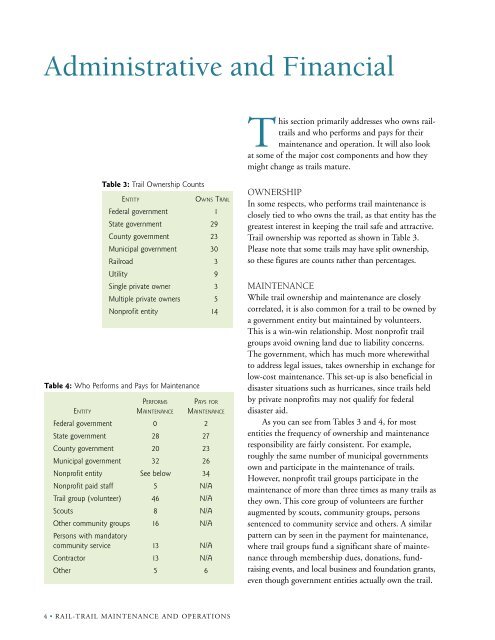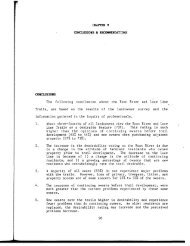Trail Maintenance and Operation - Rails-to-Trails Conservancy
Trail Maintenance and Operation - Rails-to-Trails Conservancy
Trail Maintenance and Operation - Rails-to-Trails Conservancy
Create successful ePaper yourself
Turn your PDF publications into a flip-book with our unique Google optimized e-Paper software.
Administrative <strong>and</strong> Financial<br />
This section primarily addresses who owns railtrails<br />
<strong>and</strong> who performs <strong>and</strong> pays for their<br />
maintenance <strong>and</strong> operation. It will also look<br />
at some of the major cost components <strong>and</strong> how they<br />
might change as trails mature.<br />
Table 3: <strong>Trail</strong> Ownership Counts<br />
ENTITY<br />
OWNS TRAIL<br />
Federal government 1<br />
State government 29<br />
County government 23<br />
Municipal government 30<br />
Railroad 3<br />
Utility 9<br />
Single private owner 3<br />
Multiple private owners 5<br />
Nonprofit entity 14<br />
Table 4: Who Performs <strong>and</strong> Pays for <strong>Maintenance</strong><br />
PERFORMS PAYS FOR<br />
ENTITY MAINTENANCE MAINTENANCE<br />
Federal government 0 2<br />
State government 28 27<br />
County government 20 23<br />
Municipal government 32 26<br />
Nonprofit entity See below 34<br />
Nonprofit paid staff 5 N/A<br />
<strong>Trail</strong> group (volunteer) 46 N/A<br />
Scouts 8 N/A<br />
Other community groups 16 N/A<br />
Persons with m<strong>and</strong>a<strong>to</strong>ry<br />
community service 13 N/A<br />
Contrac<strong>to</strong>r 13 N/A<br />
Other 5 6<br />
OWNERSHIP<br />
In some respects, who performs trail maintenance is<br />
closely tied <strong>to</strong> who owns the trail, as that entity has the<br />
greatest interest in keeping the trail safe <strong>and</strong> attractive.<br />
<strong>Trail</strong> ownership was reported as shown in Table 3.<br />
Please note that some trails may have split ownership,<br />
so these figures are counts rather than percentages.<br />
MAINTENANCE<br />
While trail ownership <strong>and</strong> maintenance are closely<br />
correlated, it is also common for a trail <strong>to</strong> be owned by<br />
a government entity but maintained by volunteers.<br />
This is a win-win relationship. Most nonprofit trail<br />
groups avoid owning l<strong>and</strong> due <strong>to</strong> liability concerns.<br />
The government, which has much more wherewithal<br />
<strong>to</strong> address legal issues, takes ownership in exchange for<br />
low-cost maintenance. This set-up is also beneficial in<br />
disaster situations such as hurricanes, since trails held<br />
by private nonprofits may not qualify for federal<br />
disaster aid.<br />
As you can see from Tables 3 <strong>and</strong> 4, for most<br />
entities the frequency of ownership <strong>and</strong> maintenance<br />
responsibility are fairly consistent. For example,<br />
roughly the same number of municipal governments<br />
own <strong>and</strong> participate in the maintenance of trails.<br />
However, nonprofit trail groups participate in the<br />
maintenance of more than three times as many trails as<br />
they own. This core group of volunteers are further<br />
augmented by scouts, community groups, persons<br />
sentenced <strong>to</strong> community service <strong>and</strong> others. A similar<br />
pattern can by seen in the payment for maintenance,<br />
where trail groups fund a significant share of maintenance<br />
through membership dues, donations, fundraising<br />
events, <strong>and</strong> local business <strong>and</strong> foundation grants,<br />
even though government entities actually own the trail.<br />
4 • RAIL-TRAIL MAINTENANCE AND OPERATIONS







